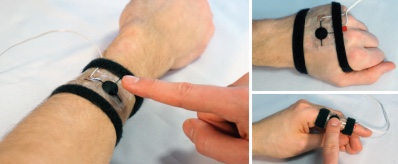Flexible sensors turn skin into a touch-sensitive interface for mobile devices
March 4, 2015

iSkin is a thin, flexible, stretchable and visually customizable touch sensor that can be worn directly on the skin. Saarland University computer scientists created three novel classes of on-body devices based on iSkin: (a) FingerStrap, exemplified here with a strap on the index finger for fast, one-handed control of incoming calls; (b) Extensions for wearable devices, exemplified here with a rollout keyboard attached to a smart watch; and SkinStickers, exemplified here with (c) an input surface for a music player attached to the forearm, (d) a click wheel on the back of the hand, and (e) a headset control behind the ear. (credit: Martin Weigel et al./CHI ’15)
Computer scientists at Saarland University and Carnegie Mellon University are studying the potential use of the human body as a touch sensitive surface for controlling mobile devices. They have developed flexible silicone rubber stickers with pressure-sensitive sensors that fit snugly to the skin.
By operating these touch input stickers, users can use their own body to control mobile devices. Because of the flexible material used, the sensors can be manufactured in a variety of shapes, sizes, and personalized designs, and can used for a variety of applications, such as extending functions of a smart watch.

Study setup on participants’ forearm, back of the hand, and finger. Two straps of Velcro allowed for fast, easy attachment. (credit: Martin Weigel et al./CHI ’15)
The iSkin uses touch-sensitive stickers use electrically conducting sensors that can be worn anywhere on the skin, made from flexible, stretchable silicone.
Researchers have developed a variety of flexible, stretchable skin sensors, as KurzweilAI has reported. This new development focuses on sensors as mobile-device interfaces.
Give me some skin
‘The stickers allow us to enlarge the input space accessible to the user as they can be attached practically anywhere on the body,” explains Martin Weigel, a PhD student in the team led by Jürgen Steimle at Saarland University. Applying pressure to the sticker could, for example, answer an incoming phone call or adjust the volume of a music player. Or a keyboard sticker could be used to type and send messages. A sticker could be rolled up and put in a pocket, explains Steimle.

iSkin touch sensing: (a) Overview of layers in a touch-sensitive iSkin; (b) sensing without touch contact; (c) capacitive sensing of slight touch events; (d) resistive sensing of firm touch events. (credit: Martin Weigel et al./CHI ’15)
Users can also design customized (bespoke) designs for iSkin patches on a computer, using a simple graphics program to create different shapes.
“The patches are ‘skin-friendly,’ as they are attached to the skin with a biocompatible, medical-grade adhesive,” said Steimle. “Users can decide where they want to position the sensor patch and how long they want to wear it.”
Currently the sensor stickers are connected via cable to a computer system. According to Steimle, microchips may in the future allow the skin-worn sensor patches to communicate wirelessly with other mobile devices.
The researchers will present their iSkin project March 16 to March 20 at the CeBit computer expo in Hanover, Germany and at the SIGCHI conference in April in Seoul, Korea.
Max Planck Institute for Informatics and Saarland University | iSkin: Flexible, Stretchable and Visually Customizable On-Body Touch Sensors for Mobile Computing
Abstract of iSkin: Flexible, stretchable and visually customizable on-body touch sensors for mobile computing
We propose iSkin, a novel class of skin-worn sensors for touch input on the body. iSkin is a very thin sensor overlay, made of biocompatible materials, and is flexible and stretchable. It can be produced in different shapes and sizes to suit various locations of the body such as the finger, forearm, or ear. Integrating capacitive and resistive touch sensing, the sensor is capable of detecting touch input with two levels of pressure, even when stretched by 30% or when bent with a radius of 0.5 cm. Furthermore, iSkin supports single or multiple touch areas of custom shape and arrangement, as well as more complex widgets, such as sliders and click wheels. Recognizing the social importance of skin, we show visual design patterns to customize functional touch sensors and allow for a visually aesthetic appearance. Taken together, these contributions enable new types of on-body devices. This includes finger-worn devices, extensions to conventional wearable devices, and touch input stickers, all fostering direct, quick, and discreet input for mobile computing.